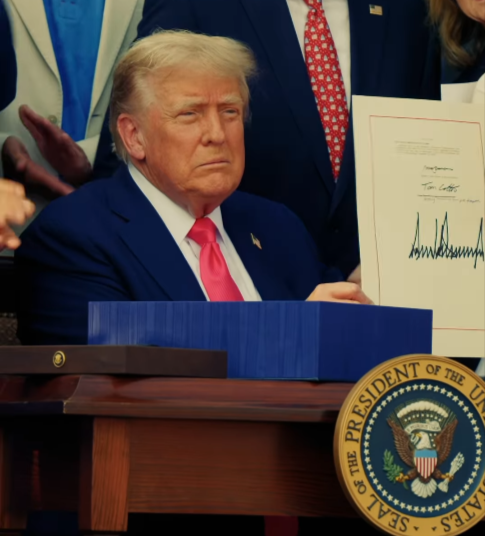
On July 4, Donald Trump signed the One Big Beautiful Bill Act (OBBBA) into law, in a celebration complete with a military flyover and a ceremonial banging of the Speaker’s gavel. The president had been pushing for a July 4 deadline for his bill for months, sidestepping between being open to push the deadline back to urging members of Congress to push forward ahead of the holiday.
As a close observer of both White House and congressional politics, I was somewhat surprised that Trump was able to pass such a major piece of legislation so early in his term. After all, only 165 days separated Trump’s second inauguration on January 20th and the signature into law of one of his major legislative priorities – one that New York Times columnist Ezra Klein dubbed “the signature legislation of Donald Trump’s term.”
Was the passage of OBBBA expeditious? Certainly – when compared to the past few presidencies.
Consider Joe Biden’s two major legislative priorities of his first term: the Bipartisan Infrastructure Law and the Build Back Better Act (the latter eventually was renamed the Inflation Reduction Act). The infrastructure legislation was signed on November 15, 2021, 229 days after Biden announced his infrastructure proposal. The IRA was not passed into law until August 16, 2022, nearly nine months after the Bipartisan Infrastructure Law was adopted – and 291 days after Biden announced the plan, on October 29, 202 (although Congressional Democrats had been debating the bill since the spring of 2021).
Or consider Trump’s marquee legislative enactments during his first term. He signed the Tax Cuts and Jobs Act of 2017 (also known as TCJA) 336 days after inauguration. And Trump’s signature North American trade agreement, known as the United States-Mexico-Canada Agreement (USMCA), was signed into law on January 29, 2020 – three years after he took office.
And then there is President Barack Obama’s signature health-care law, the Affordable Care Act (also known as Obamacare). It was signed into law on March 23, 2010, 427 days into his first term as president.
The big takeaway here? Across each of these cases, Trump’s Big Beautiful Bill made it into law faster than his recent predecessors’ legislative priorities did. What can help explain that?
In each of the aforementioned cases – except for the USMCA in Trump’s first term – presidents were assisted by unified party control — their party was in the White House and had majorities in both chambers of Congress. While party seat control in Congress has shrunk in recent years, majority parties – regardless of their size – still have major advantages over their minority counterparts. Chief among them is deciding what to vote on and when.
But why did the OBBA move faster than Biden’s two big bills or Obama’s healthcare law? There appear to be a few factors, including empowering lawmakers to make critical decisions regarding the legislation and Trump’s ability to put pressure on co-partisans who had expressed concerns about the bill.
In the Senate, Republicans gave Budget Committee Chair Lindsey Graham (R-SC) the sole authority to determine whether or not provisions in the legislation violated budget laws. Previously, Senate Democrats wanted to bring Republicans to the table in meeting with the parliamentarian – the chamber’s non-partisan rules referee – to determine what could be included in the reconciliation legislation, an invitation that Republicans declined. Some scholars have even claimed “Republicans nuked the filibuster, stealthily” by adopting the “current policy baseline.”
Trump’s status as the clear Republican leader and his ability to put pressure on his fellow partisans helped get the legislation passed quickly. Klein, in the same podcast episode previously mentioned, noted that if Trump wanted a certain provision in the legislation, he would get it. “Republicans have very strong leadership in the form of Donald Trump.”
Throughout the bill’s discussion and debate period, Trump met with senators to sell them on the legislation. Once the Senate had passed the bill, Trump invited potential GOP holdouts to the White House to pressure them into voting for the legislation. He also took to Truth Social and cautioned skeptical Republicans by saying that the legislation “SHOULD BE AN EASY YES VOTE. RIDICULOUS!!!” and “MAGA IS NOT HAPPY, AND IT’S COSTING YOU VOTES!!!” The President outright threatened to primary Rep. Thomas Massie (R-KY) for opposing the bill.
Lawmakers, naturally, want to keep their jobs and get re-elected, and Trump’s high success rate in endorsing primary winners and previous threats to challenge inobedient Republicans in their races certainly incentivizes GOP lawmakers to adhere to the president’s wishes.
All in all, a combination of these factors helped Donald Trump and congressional Republicans pass a major legislative priority that most certainly will be a hallmark of his legislative agenda. Procedurally, the One Big Beautiful Bill was a feat – with a short deadline to pass and a major balancing act from Trump and Republican leaders to keep their party united behind the bill.
As one-time Senate Majority Leader Mike Mansfield said about the issue of civil rights in 1964, “Great public issues are not subject to our personal timetables… They emerge in their own way and in their own time. We do not compel them, they compel us.”
Yet, for the One Big Beautiful Bill Act, the legislative agenda seemed to march to the beat of one man: President Trump himself.
John C. Paschold is a graduate student in political science at Vanderbilt University, with a concentration in American politics. His areas of interest include legislative and executive politics, political parties, campaigns and elections, public opinion, and political history.
Stay in the know about our news and events.